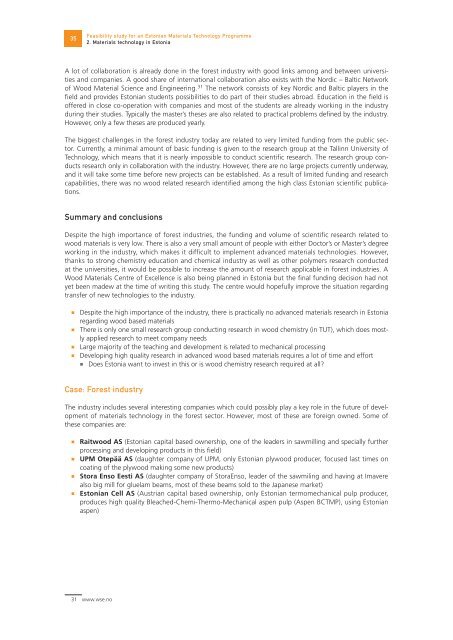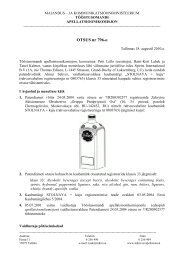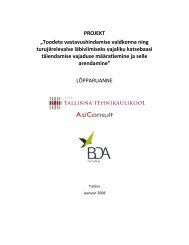Feasibility study for an Estonian Materials Technology Programme
Feasibility study for an Estonian Materials Technology Programme
Feasibility study for an Estonian Materials Technology Programme
You also want an ePaper? Increase the reach of your titles
YUMPU automatically turns print PDFs into web optimized ePapers that Google loves.
35<br />
<strong>Feasibility</strong> <strong>study</strong> <strong>for</strong> <strong>an</strong> Estoni<strong>an</strong> <strong>Materials</strong> <strong>Technology</strong> <strong>Programme</strong><br />
2. <strong>Materials</strong> technology in Estonia<br />
A lot of collaboration is already done in the <strong>for</strong>est industry with good links among <strong>an</strong>d between universities<br />
<strong>an</strong>d comp<strong>an</strong>ies. A good share of international collaboration also exists with the Nordic – Baltic Network<br />
of Wood Material Science <strong>an</strong>d Engineering. 31 The network consists of key Nordic <strong>an</strong>d Baltic players in the<br />
field <strong>an</strong>d provides Estoni<strong>an</strong> students possibilities to do part of their studies abroad. Education in the field is<br />
offered in close co-operation with comp<strong>an</strong>ies <strong>an</strong>d most of the students are already working in the industry<br />
during their studies. Typically the master’s theses are also related to practical problems defined by the industry.<br />
However, only a few theses are produced yearly.<br />
The biggest challenges in the <strong>for</strong>est industry today are related to very limited funding from the public sector.<br />
Currently, a minimal amount of basic funding is given to the research group at the Tallinn University of<br />
<strong>Technology</strong>, which me<strong>an</strong>s that it is nearly impossible to conduct scientific research. The research group conducts<br />
research only in collaboration with the industry. However, there are no large projects currently underway,<br />
<strong>an</strong>d it will take some time be<strong>for</strong>e new projects c<strong>an</strong> be established. As a result of limited funding <strong>an</strong>d research<br />
capabilities, there was no wood related research identified among the high class Estoni<strong>an</strong> scientific publications.<br />
Summary <strong>an</strong>d conclusions<br />
Despite the high import<strong>an</strong>ce of <strong>for</strong>est industries, the funding <strong>an</strong>d volume of scientific research related to<br />
wood materials is very low. There is also a very small amount of people with either Doctor’s or Master’s degree<br />
working in the industry, which makes it difficult to implement adv<strong>an</strong>ced materials technologies. However,<br />
th<strong>an</strong>ks to strong chemistry education <strong>an</strong>d chemical industry as well as other polymers research conducted<br />
at the universities, it would be possible to increase the amount of research applicable in <strong>for</strong>est industries. A<br />
Wood <strong>Materials</strong> Centre of Excellence is also being pl<strong>an</strong>ned in Estonia but the final funding decision had not<br />
yet been madew at the time of writing this <strong>study</strong>. The centre would hopefully improve the situation regarding<br />
tr<strong>an</strong>sfer of new technologies to the industry.<br />
Despite the high import<strong>an</strong>ce of the industry, there is practically no adv<strong>an</strong>ced materials research in Estonia<br />
regarding wood based materials<br />
There is only one small research group conducting research in wood chemistry (in TUT), which does mostly<br />
applied research to meet comp<strong>an</strong>y needs<br />
Large majority of the teaching <strong>an</strong>d development is related to mech<strong>an</strong>ical processing<br />
Developing high quality research in adv<strong>an</strong>ced wood based materials requires a lot of time <strong>an</strong>d ef<strong>for</strong>t<br />
Does Estonia w<strong>an</strong>t to invest in this or is wood chemistry research required at all?<br />
Case: Forest industry<br />
The industry includes several interesting comp<strong>an</strong>ies which could possibly play a key role in the future of development<br />
of materials technology in the <strong>for</strong>est sector. However, most of these are <strong>for</strong>eign owned. Some of<br />
these comp<strong>an</strong>ies are:<br />
Raitwood AS (Estoni<strong>an</strong> capital based ownership, one of the leaders in sawmilling <strong>an</strong>d specially further<br />
processing <strong>an</strong>d developing products in this field)<br />
UPM Otepää AS (daughter comp<strong>an</strong>y of UPM, only Estoni<strong>an</strong> plywood producer, focused last times on<br />
coating of the plywood making some new products)<br />
Stora Enso Eesti AS (daughter comp<strong>an</strong>y of StoraEnso, leader of the sawmiling <strong>an</strong>d having at Imavere<br />
also big mill <strong>for</strong> gluelam beams, most of these beams sold to the Jap<strong>an</strong>ese market)<br />
Estoni<strong>an</strong> Cell AS (Austri<strong>an</strong> capital based ownership, only Estoni<strong>an</strong> termomech<strong>an</strong>ical pulp producer,<br />
produces high quality Bleached-Chemi-Thermo-Mech<strong>an</strong>ical aspen pulp (Aspen BCTMP), using Estoni<strong>an</strong><br />
aspen)<br />
31 www.wse.no





